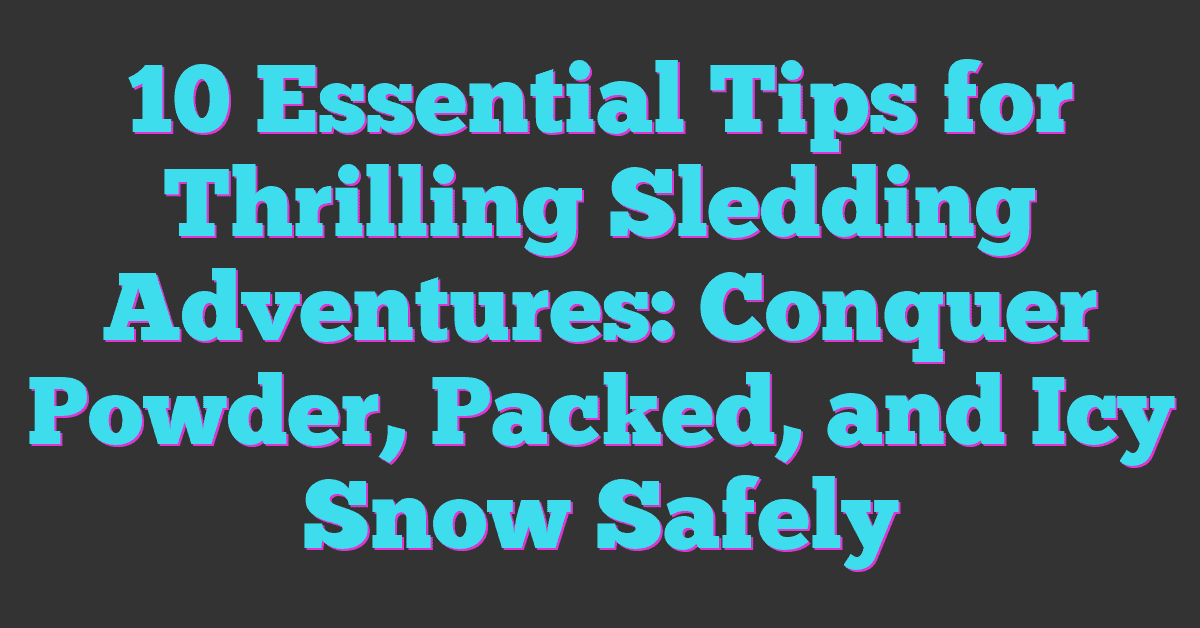If you’re a fan of winter activities, then sledding is probably high up on your list. There’s nothing quite like the thrill of racing down a snowy hill on a sled. But have you ever wondered how much snow is actually needed to have a good sledding experience? Well, in this article, we’ll explore just that. Whether you’re a snow-loving enthusiast or a parent looking to entertain your kids, we’ll break down the snow requirements for a fun-filled sledding adventure.

When it comes to sledding, the amount of snow needed can vary depending on a few factors. The type of sled you’re using, the slope of the hill, and the weight of the sledder all play a role in determining how much snow is necessary. In general, however, you’ll want at least a few inches of snow on the ground to ensure a smooth and enjoyable ride. But don’t worry, we’ll provide you with some helpful tips to make the most out of even the smallest snowfall.
You might be wondering why the amount of snow matters when it comes to sledding. Well, having enough snow is crucial for a few reasons. Firstly, it helps create a slippery surface that allows the sled to glide smoothly down the hill. Secondly, a sufficient amount of snow helps cushion the ride, preventing any bumps or jolts that could make the experience less enjoyable. So, let’s dive into the specifics and find out just how much snow you need to hit the slopes and have a blast sledding.
How Much Snow is Needed for Sledding?
As an avid snow sports enthusiast, you know that sledding is one of the most thrilling and enjoyable winter activities. The feeling of gliding down a snow-covered hill at high speeds is pure exhilaration. But how much snow does it actually take to have a great sledding experience?
The amount of snow needed for sledding depends on various factors. First and foremost, you need enough snow to create a smooth and slippery surface for your sled. The general rule of thumb is that you’ll want at least a few inches of snow on the ground. This will provide enough coverage to ensure a smooth and fast ride.
Another factor to consider is the type of sled you’re using. Different sleds perform better on different snow conditions. For instance, plastic sleds tend to glide more easily on packed snow, whereas wooden sleds might require a bit more snow to prevent excessive friction. Keep in mind that heavier sleds may require more snow to provide enough momentum for a fun ride.
The slope of the hill also plays a role in determining how much snow is needed. Steeper hills require less snow because gravity helps the sled maintain speed. On the other hand, if you’re sledding on a gentle slope, you may need a bit more snow to compensate for the lack of natural momentum.
Lastly, consider your weight as a sledder. If you’re on the lighter side, you may need less snow to achieve a fast and exhilarating ride. Conversely, if you’re on the heavier side, you’ll require a bit more snow to ensure a smooth glide.
Factors to Consider for Sledding in Snow
When it comes to sledding, there are a few factors to keep in mind to ensure a fun and exhilarating experience. As an avid snow sports enthusiast, you know that the right conditions can make all the difference. So, before you grab your sled and head out, here are some factors to consider for sledding in the snow:
1. Snow Depth
The amount of snow on the ground plays a crucial role in determining how well your sled will glide. Generally, a few inches of snow is sufficient to provide a smooth ride. It’s important to have enough snow to create a slippery surface, allowing your sled to effortlessly glide downhill. However, too much snow can slow you down or make it difficult to control your sled.
2. Type of Sled
The type of sled you choose can also impact your sledding experience. Plastic sleds tend to glide more easily on packed snow, requiring less snow depth for optimal performance. On the other hand, wooden sleds may need a bit more snow to prevent excessive friction. Consider the type of sled you have and its interaction with the snow when determining how much snow you need.
3. Slope of the Hill
The slope of the hill you plan to sled on is another important factor. Steeper hills require less snow due to gravity helping maintain speed. A gentle slope, on the other hand, may require more snow to ensure a fast and enjoyable ride. Take into account the slope of the hill to gauge how much snow will be needed for a thrilling sledding adventure.
4. Weight of the Sledder
Believe it or not, your weight plays a role in how much snow you need for sledding. Lighter individuals will require less snow to achieve a fast ride, while heavier individuals may need more snow for a smoother glide. Consider the weight of the sledder when determining the amount of snow needed for an optimal sledding experience.
Remember, these factors can vary depending on personal preferences and the specific conditions of the snow. Always use caution and assess the snow conditions before embarking on your sledding adventure. So, bundle up, grab your sled, and enjoy the thrill of sledding in the winter wonderland!
Ideal Snow Depth for Sledding
As an avid snow sports enthusiast, you know that the perfect conditions can make all the difference in your sledding experience. When it comes to how much snow you need to go sledding, the ideal snow depth plays a crucial role. It’s what makes the ride smooth, fast, and enjoyable.
When you head out for a sledding adventure, aim for at least a few inches of snow on the ground. This will provide enough coverage to create a slippery surface for your sled to glide on. Without sufficient snow depth, you might find yourself getting stuck or experiencing a bumpy ride. Nobody wants that!
Keep in mind that the type of sled you have also affects the amount of snow you need. If you’re using a plastic sled, a thin layer of packed snow will do. These sleds are designed to glide effortlessly on smoother surfaces. On the other hand, if you’re using a wooden sled, you’ll need a bit more snow. The wood creates more friction, so a thicker layer of snow helps to reduce that resistance.
Another factor that comes into play is the slope of the hill. Steep hills require less snow because gravity helps you maintain speed. However, on flatter hills, you’ll need a bit more snow to keep the momentum going. So, choose your sledding spot wisely, considering the terrain you have in mind.
Your weight also plays a role in determining how much snow you need. Lighter individuals will need less snow to ensure a fast and exhilarating ride. Conversely, if you’re on the heavier side, you’ll need more snow to provide a smooth glide, as excessive weight can cause the sled to sink into the snow.
Best Types of Snow for Sledding
When it comes to sledding, as an avid snow sports enthusiast, you know that the type of snow can make all the difference in your sledding experience. Here are a few things to consider when it comes to finding the best types of snow for a smooth and enjoyable ride:
1. Fresh Powder:
Freshly fallen snow is like a blank canvas waiting to be sculpted into a thrilling sledding run. The light, fluffy texture creates a cushioning effect, allowing your sled to glide smoothly across the surface. Look for snow that is light and powdery, with minimal tracks or footprints. It’s important to note that deep powder may require a bit more effort to navigate, so choose your hill wisely.
2. Packed Snow:
Packed snow occurs when other sledders have already made their tracks down the hill. This type of snow provides a compact and firm surface, allowing for faster speeds and greater control. Packed snow is often found on popular sledding hills or areas that have been groomed for winter sports. Be sure to check if sledding restrictions are in place before heading out.
3. Slushy Snow:
As temperatures start to rise, you may find yourself sliding down hills covered in slushy snow. This wet and heavy snow can make for a slower ride, but it can also create a fun challenge. The key is to embrace the sloppy conditions and adjust your technique accordingly. Slushy snow is a great option for beginners or those looking for a more relaxed and laid-back sledding experience.
Tips for Safe and Fun Sledding
When it comes to sledding, safety should always be a top priority. Here are some tips to ensure you have a safe and fun sledding experience:
- Choose the right location: Look for a hill that is free of obstacles such as trees, rocks, or other people. Make sure the hill has a gradual slope and is not too steep to avoid excessive speed or the risk of collision.
- Check the conditions: Before heading out, assess the snow conditions. Fresh powder can provide a softer landing, while packed snow offers faster speeds. Keep in mind that icy or hard-packed snow may increase the risk of injury, so it’s best to avoid sledding on those surfaces.
- Dress appropriately: Dress in layers to stay warm and keep moisture away from your body. Wear waterproof pants and jackets to protect yourself from wet snow. Don’t forget to wear a helmet to protect your head in case of any falls or collisions.
- Use a sturdy sled: Invest in a well-made sled that can withstand the rigors of sledding. Avoid using makeshift sleds, as they may not offer the same level of stability or control. Look for sleds with handles or ropes that allow you to steer and brake.
- Observe sledding etiquette: Be mindful of other sledders and take turns going down the hill. Stay in control of your sled at all times and be aware of your surroundings. Avoid sledding too close to the bottom of the hill to prevent collisions.
- Know your limits: Sledding can be exhilarating, but it’s important to know your skill level and avoid taking unnecessary risks. Start with gentle slopes and gradually work your way up to more challenging hills as you gain confidence and experience.
Conclusion
Now that you know how much snow you need to go sledding, you can hit the slopes with confidence. Remember, a few inches of snow on the ground is ideal for a smooth and enjoyable ride. Consider the type of sled you’re using, as plastic sleds require less snow than wooden ones. The slope of the hill also plays a role, with steeper hills requiring less snow due to gravity. Your weight is another factor, with lighter individuals needing less snow for a fast ride and heavier individuals needing more snow for a smooth glide.
When it comes to finding the best types of snow for sledding, fresh powder provides a cushioning effect and allows for a smooth glide, packed snow offers faster speeds and greater control, and slushy snow can create a fun challenge. Remember to prioritize safety by choosing a hill that is free of obstacles and has a gradual slope. Always assess the snow conditions before heading out and dress appropriately to stay warm and protected. Use a sturdy sled and follow sledding etiquette to avoid collisions. Start with gentle slopes and know your limits before attempting more challenging hills.
So grab your sled, find the perfect hill, and enjoy the thrill of sledding in the winter wonderland!











